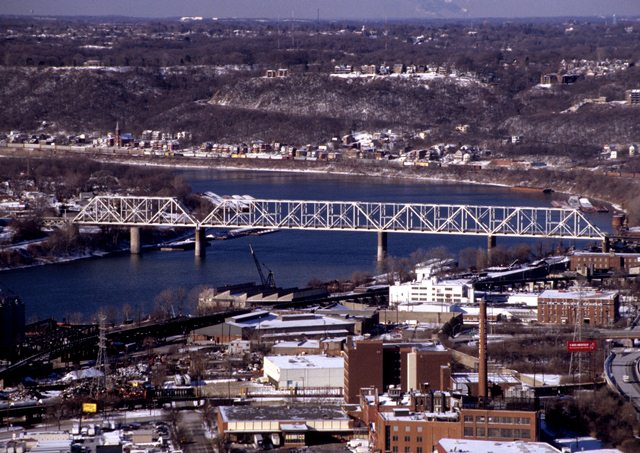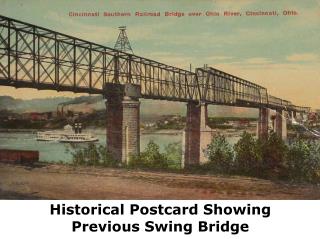We Recommend:
Bach Steel - Experts at historic truss bridge restoration.
BridgeHunter.com Phase 1 is released to the public! - Visit Now
Cincinnati Southern Railroad Bridge

Primary Photographer(s): Dave Michaels
Bridge Documented: 2007, 2008, 2011
Ludlow and Cincinnati: Kenton County, Kentucky and Hamilton County, Ohio: United States
Metal Continuous 14 Panel Multiple-Type-Connected Baltimore Through Truss, Fixed and Approach Spans: Metal 10 Panel Rivet-Connected Baltimore Through Truss, Movable: Vertical Lift
1922 By Builder/Contractor: American Bridge Company of New York, New York and Engineer/Design: Ralph Modjeski
Not Available or Not Applicable
519.0 Feet (158.2 Meters)
3,240.0 Feet (987.6 Meters)
32.3 Feet (9.85 Meters)
3 Main Span(s)
Not Applicable

View Information About HSR Ratings
Bridge Documentation
View A Detailed Historical Paper About This Bridge
View A Historical Article About This Bridge
View A Historical Book About The Cincinnati Southern Railway
As configured today, from north to south, the bridge consists of a series of deck plate girder spans, three continuous through truss spans over the majority of the Ohio River, a simple through truss span over the southern portion of the Ohio River, and finally, a Warren deck truss span.
The bridge seen today is a replacement for a 1877 bridge, and the piers from the 1877 bridge were enlarged and reused to construct the 1922 bridge. The 1877 bridge was a Whipple through truss bridge built by the Keystone Bridge Company of Pittsburgh, Pennsylvania and designed by J. H. Linville. It included a large through truss swing span at the southern end of the bridge, allowing tall boats to pass under the bridge near the southern shore of the river. The remaining spans over the river were fixed through truss spans, and the largest of those spans, 519 feet in length, was when completed the largest truss span in the world. In 1922, the bridge was reconstructed into the bridge seen today. The 1877 bridge was kept open to traffic with the larger 1922 bridge carefully built around the old truss. Because the new bridge was larger, the original stone piers had to be enlarged with a combination of steel and concrete. As for the southern movable span, the swing span was replaced with a through truss vertical lift span. The lift span was not designed to lift up a very large distance, only 13 feet, as only a small lift height was needed to accommodate the boats during high water events. However, the 3,000,000 pound lift span was claimed to be the heaviest lift span in the world when completed. The lift span operated using hydraulic lifting jacks, rather than the more common method of using motors. Switching to a vertical lift bridge left the circular swing pier in the middle of this span without a purpose. Oddly, the swing pier was not removed despite this fact, and the pier remains today, a pier with nothing resting on it. Today, the vertical lift span no longer raises for boats, and most of the lift towers and machinery have been removed. Only a few clues remain as to this span's past including part of one tower left in place and the unusual bearings for this bridge that would not be found on a fixed truss span.
This bridge was designed by famous bridge engineer Ralph Modjeski and constructed by the prolific American Bridge Company. The piers were enlarged by the Foundation Company. All connections are riveted except for some of the diagonal members and bottom chord segments on the continuous spans.
This bridge is historically significant as an example of a continuous truss, and a bridge associated with famous engineer Ralph Modjeski. The bridge remains in use by trains and is described as the busiest railroad bridge in the area.
![]()
Photo Galleries and Videos: Cincinnati Southern Railroad Bridge
Bridge Photo-Documentation
Original / Full Size PhotosA collection of overview and detail photos. This gallery offers photos in the highest available resolution and file size in a touch-friendly popup viewer.
Alternatively, Browse Without Using Viewer
![]()
Bridge Photo-Documentation
Mobile Optimized PhotosA collection of overview and detail photos. This gallery features data-friendly, fast-loading photos in a touch-friendly popup viewer.
Alternatively, Browse Without Using Viewer
![]()
Maps and Links: Cincinnati Southern Railroad Bridge
Coordinates (Latitude, Longitude):
Search For Additional Bridge Listings:
Bridgehunter.com: View listed bridges within 0.5 miles (0.8 kilometers) of this bridge.
Bridgehunter.com: View listed bridges within 10 miles (16 kilometers) of this bridge.
Additional Maps:
Google Streetview (If Available)
GeoHack (Additional Links and Coordinates)
Apple Maps (Via DuckDuckGo Search)
Apple Maps (Apple devices only)
Android: Open Location In Your Map or GPS App
Flickr Gallery (Find Nearby Photos)
Wikimedia Commons (Find Nearby Photos)
Directions Via Sygic For Android
Directions Via Sygic For iOS and Android Dolphin Browser
USGS National Map (United States Only)
Historical USGS Topo Maps (United States Only)
Historic Aerials (United States Only)
CalTopo Maps (United States Only)





